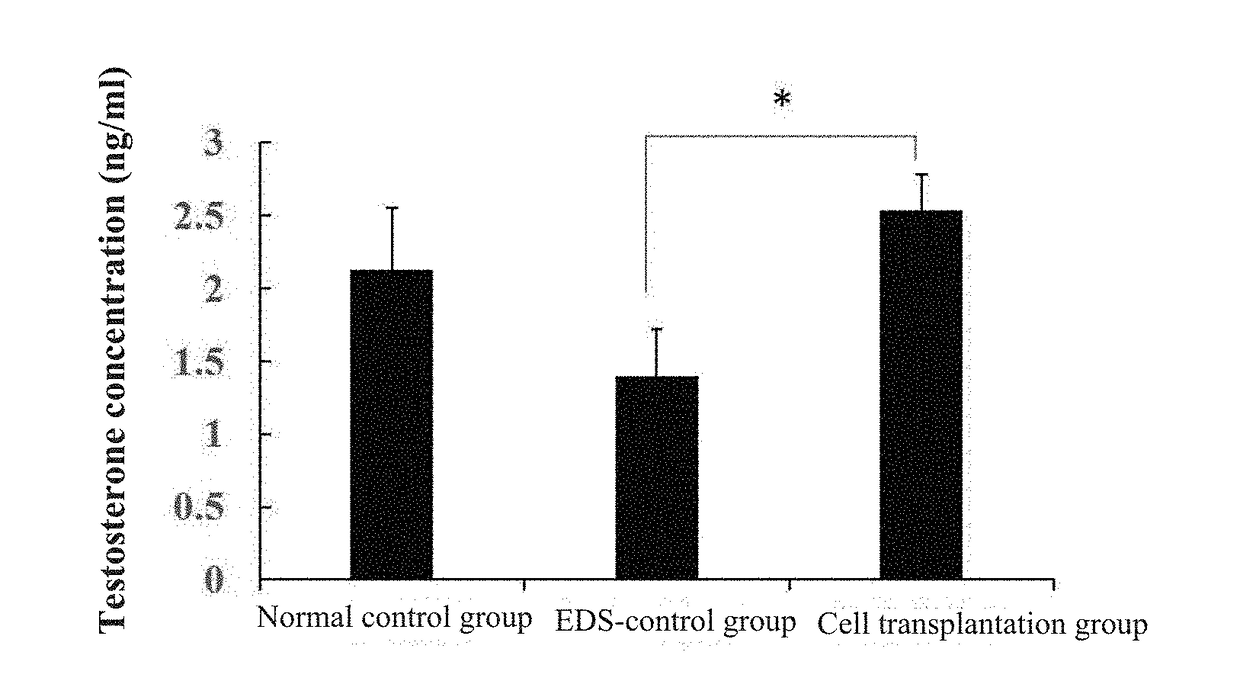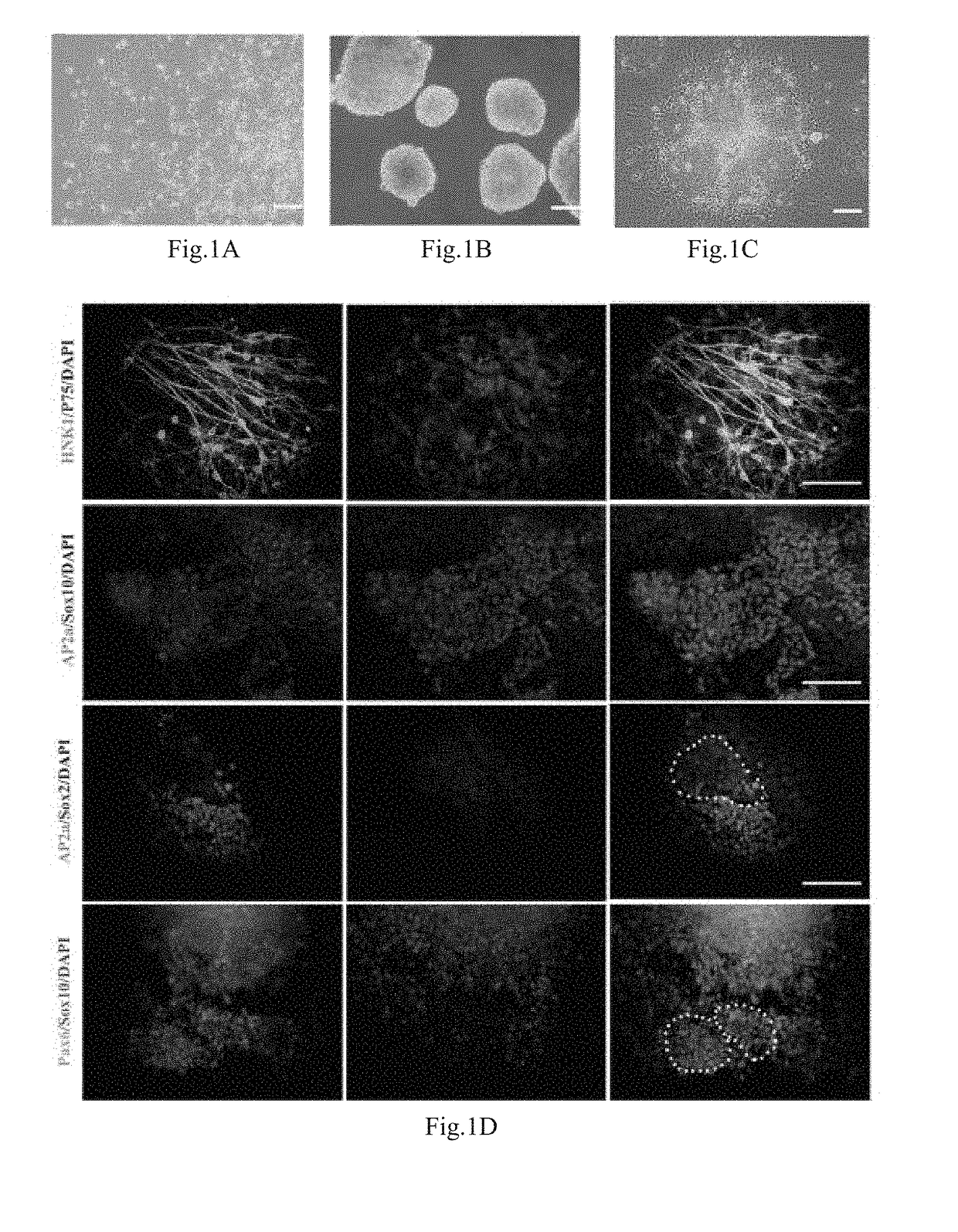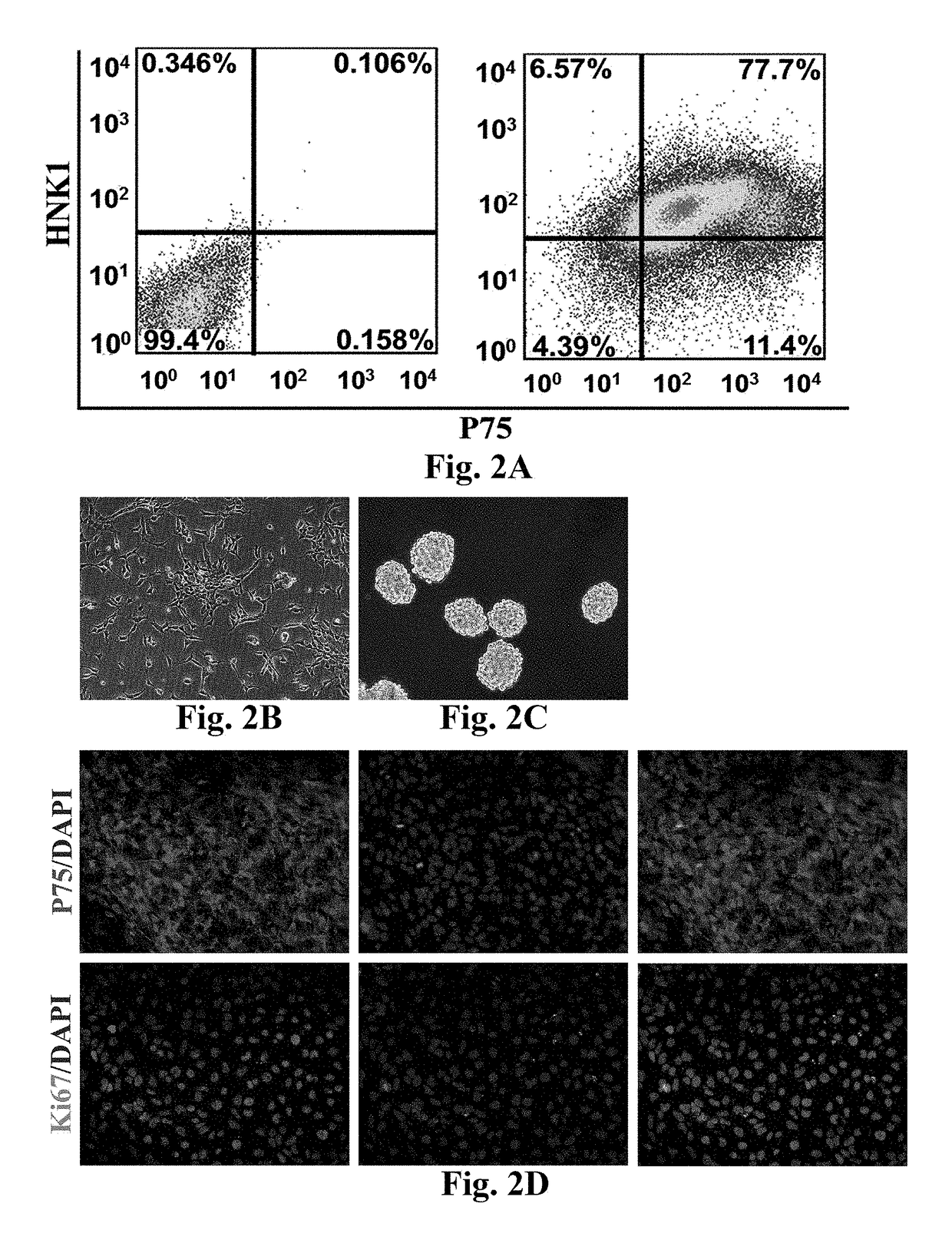Method of Committed Differentiation of Human Induced Pluripotent Stem Cells into Leydig Cells and Application of Leydig Cells
a technology of human induced pluripotent stem cells and committed differentiation, applied in the field of stem cells and tissue engineering, can solve the problems of difficult control of supplemental dose, difficult to mimic physiological testosterone secretion and characteristics, various complications and side effects, etc., to achieve effective restoration of serum and intratesticular testosterone concentration, avoid negative effects of therapeutic process, and improve therapeutic
- Summary
- Abstract
- Description
- Claims
- Application Information
AI Technical Summary
Benefits of technology
Problems solved by technology
Method used
Image
Examples
embodiment 1
[0060]Differentiation From a Human-induced Pluripotent Stem (hiPS) Cell Line to Human Neural Crest Stem Cells (hNCSCs)
[0061](1) preparation of cell suspension: with an established human iPS cell line (hiPSCs, Hum Mol Genet. 2013,22(11): 2221 -33), human induced pluripotent stem cells (hiPSCs) grew in a flat cloning form when subjected to expansion culture on Matrigel, and were closely arrayed, as shown in FIG. 1A. The hiPSCs were digested into small masses with EDTA at the concentration of 0.5 mmol / L, and were resuspended by a ROCK inhibitor-containing mTeSR culture medium, wherein a used ROCK inhibitor is Y27632 (Calbiochem, San Diego, Calif.).
[0062](2) committed differentiation: suspension cells were collected, then inoculated in a Petri culture dish, and subjected to suspension culture by a neural differentiation culture medium (80 percent of Knockout™ DMEM, 18 percent of Knockout™ SR, 1 percent (V / V) of Penicillin-Streptomycin solution, 1 mM of L-glutamine, and 0.1 mM of β-merca...
embodiment 2
[0069]Differentiation From Human Neural Crest Stem Cells (hNCSCs) to Leydig Cells (hiPS-hNCSCs-LCs or hNCSCs-LCs)
[0070]When the hNCSCs obtained by expansion reached the density of 60 percent confluence, the culture medium was replaced by a Leydig cells (LCs) differentiation culture medium (obtained by adding 2 volume percent of fetal calf serum (FCS), 1 nM of triiodothyronine (T3) (Sigma, T2877), 1 ng / ml of luteinizing hormone (LH) (Sigma, L6420), 70 ng / ml of an insulin-like growth factor (IGF-I) (PeproTech, 100-11), and 10 ng / ml of a platelet-derived growth factor BB (PDGF-BB) (PeproTech, 500-P47) into a DMEM-F12 culture medium (Hyclone, SH30023.018) for induction for 14 days and for cell differentiation, then cellular supernatant was collected, and cells were fixed by 4% PFA. Expression of mature LCs-related markers including 3β-HSD, P450c17, steroidogenic acute regulatory protein (StAR), and steroidogenic factor 1 (SF-1) were detected via immunofluorescence. As shown in FIG. 5, i...
embodiment 3
[0071]Effect of hiPS-hNCSCs-LCs (or hNCSCs-LCs) In Vivo
[0072]The previous research showed that the Leydig cells in a rat could be exhausted 4 days after treated by a specific apoptosis inducer ethane dimethyl sulfonate (EDS), so that the EDS was injected to the abdominal cavity of the rat to establish an EDS model. Adult rats were randomly divided into three groups, including a normal control group, an EDS-control group and a cell transplantation group. For the rats in the normal control group, normal saline with the same volume was injected intraperitoneally respectively on the day 1 and the day 4. For the rats in the EDS-control group, EDS (75 mg / kg weight) was injected intraperitoneally on the first day, and 20 μl of normal saline (10 μl / unilateral testicle) was injected intraperitoneally on the day 4. For the rats in the cell group, EDS (75 mg / kg weight) was injected intraperitoneally on the day 1, and the hNCSCs-LCs (1.5×106 resuspended in 10 μl of PBS / unilateral testicle) cult...
PUM
| Property | Measurement | Unit |
|---|---|---|
| V/V | aaaaa | aaaaa |
| V/V | aaaaa | aaaaa |
| V/V | aaaaa | aaaaa |
Abstract
Description
Claims
Application Information
 Login to View More
Login to View More - R&D
- Intellectual Property
- Life Sciences
- Materials
- Tech Scout
- Unparalleled Data Quality
- Higher Quality Content
- 60% Fewer Hallucinations
Browse by: Latest US Patents, China's latest patents, Technical Efficacy Thesaurus, Application Domain, Technology Topic, Popular Technical Reports.
© 2025 PatSnap. All rights reserved.Legal|Privacy policy|Modern Slavery Act Transparency Statement|Sitemap|About US| Contact US: help@patsnap.com



